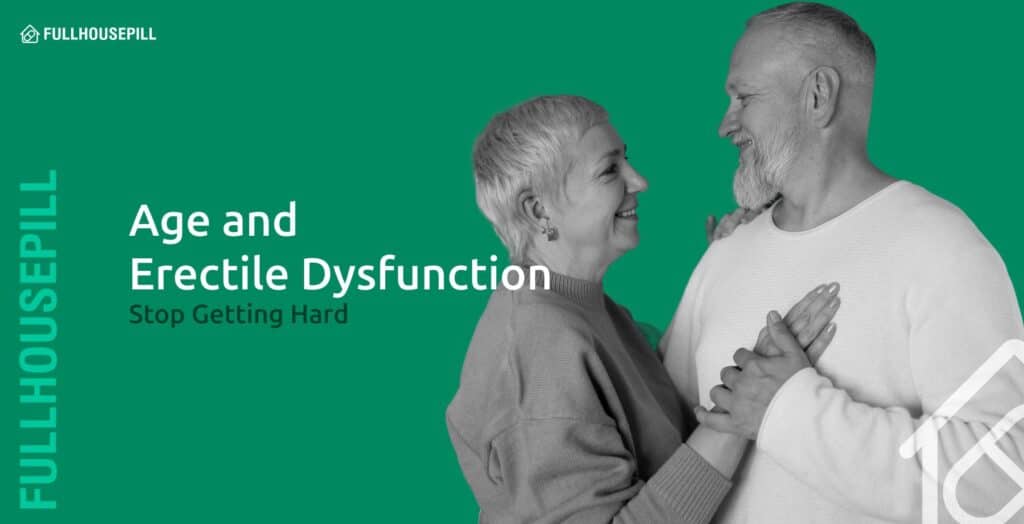Erectile dysfunction (ED) is a male sexual health condition that impairs the ability to achieve and maintain an erection during sexual intercourse. Occasional erectile difficulty is common and not medically concerning unless it becomes persistent. Persistent ED can cause psychological stress and negatively affect intimate relationships.
Sexual arousal is a complex process that involves hormonal signals, emotional triggers, the nervous system, muscular response, and vascular flow. Erectile dysfunction may result from dysfunction in any of these physiological components. Moreover, age has a significant influence on erectile function and overall sexual performance. Although aging does not directly cause ED, it increases the risk of developing it in men.
A research study published in the journal Translational Andrology and Urology in 2017 shows that the prevalence of ED is approximately 40% at age 40, 50% at age 50, and increases with age. The study also identified corporal veno-occlusive dysfunction (CVOD) or venous leakage as a common cause in ED patients. CVOD is a condition where blood “leaks out” of the blood capillaries of penis which results in the loss of erection.
A major age-related contributor to ED is the natural decline in testosterone levels. However, testosterone is not the sole contributing factor. Both physical and psychosocial well-being are essential for sexual function and tend to decline with age. Adopting regular exercise and a nutrient-rich diet can improve vascular and hormonal health, thereby reducing the risk of ED.
At What Age Do Men Stop Getting Hard?
There is no specific age for men to develop ED. In fact, some men never experience ED in their lifetime. However, most men experience ED at some point in their lives. According to the research article published in European Urology Focus (2023), the prevalence of ED in men without any comorbidities (additional risk factors) increased from 10% at age 40 to 79% at age 80. It also found that in healthy men aged 50 and 75, the probability was 20% and 68%, respectively. But the probability increased to 41% and 85%, respectively, for men with hypertension, obesity, and diabetes. Men with several comorbidities have the same risk of ED as that of healthy men 15 to 25 years older.
A 2017 study in Translational Andrology and Urology estimated that men in their 40s have a 40% chance of experiencing ED, with prevalence increasing by approximately 10% each subsequent decade.
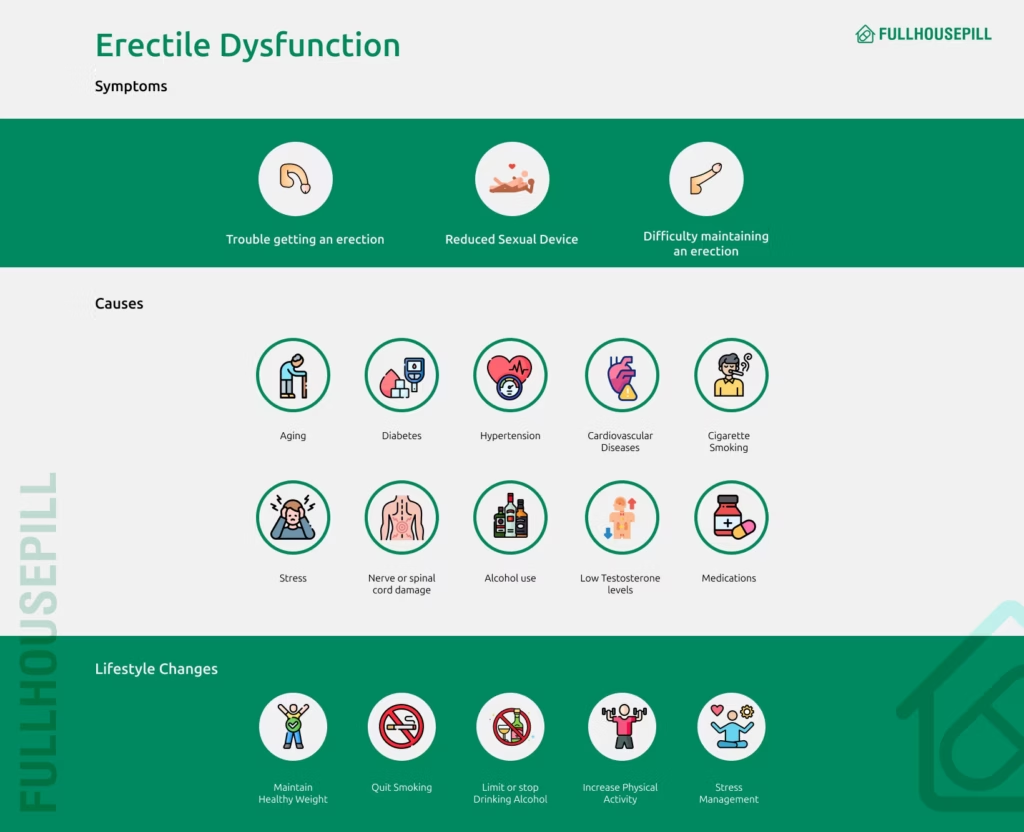
How Does Age Affect Sexual Health in Men?
Sexual function in men over 40 years of age declines mainly because of the decreased production of testosterone and sclerosis (i.e., degeneration) of the seminiferous tubules that carry sperm cells. Reduced testosterone levels lead to lower libido and slower sexual response, although complete loss of sexual function is uncommon.
BPH (benign prostatic hyperplasia) affects about 50% of men, mostly aged over 40 years. BPH leads to an enlarged prostate gland, which causes urinary and ejaculation issues.
However, while age alone may not directly impair sexuality, it increases the likelihood of health conditions that do. Sexual dysfunction in older men often results from underlying medical conditions and medication side effects. For example, diabetes, high blood pressure, depression, and anxiety increase the risk of ED. The penis undergoes age-related structural and vascular changes that contribute to erectile dysfunction.
Aging-Related Physiological Changes in the Penis
Physiological changes in the penis typically begin after the age of 40. As testosterone production declines, the size, shape, and function of the penis may change. Additionally, the refractory period (the time after ejaculation when a man is unable to achieve a second orgasm) increases with age. A 2001 study published in Psychiatry Online titled Men’s Sexual Health After Midlife establishes this.
High blood pressure (hypertension) can also contribute to erectile dysfunction and potentially lead to a perception of penis shrinkage, though it’s not a direct cause of physical shrinkage. Hypertension damages blood vessels, limiting blood flow to the penis, which is essential for erections. This may cause ED, where incomplete blood filling of erectile tissue leads to smaller or weaker erections.
Testicular shrinkage from low testosterone levels further increases the risk of ED. By age 50, the corpus cavernosum may lose some of its ability to relax, impairing the erectile process. Reduced smooth muscle function contributes to erectile dysfunction. Age-related vascular damage impairs vasodilation, limiting the blood flow needed for erection.
Another condition called symptomatic venous leakage or CVOD is a common age-related cause of ED. It refers to the excessive venous outflow that prevents sufficient pressure in the erectile tissues to maintain an erection. Although this also affects young men, its prevalence increases with age.
The penis becomes less sensitive with age and requires more stimulation and time to get aroused. With age, repetitive trauma may lead to scar tissue formation on the penis. These can build up by the age of 50 and bend the penis (Peyronie’s disease).
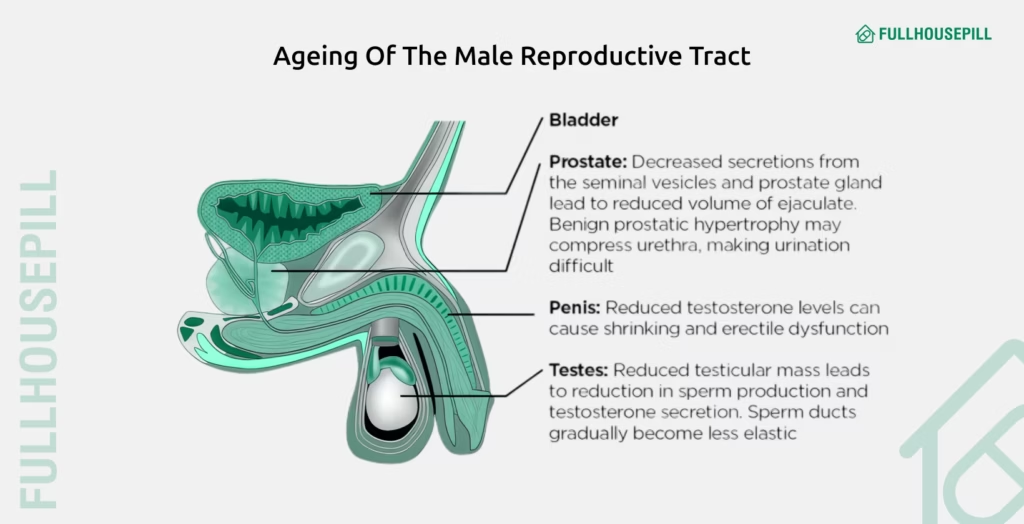
Chronic Health Conditions
Having chronic health conditions like diabetes, high blood pressure, and obesity makes an individual more prone to ED. A research paper published in European Urology Focus, titled Relationship Between Age, Comorbidity, and the Prevalence of Erectile Dysfunction (2023), examined the link between the incidence of ED and pre-existing medical conditions (cardiovascular diseases, diabetes, and hypertension). The results showed that people suffering from long-term health conditions like diabetes, hypertension, and other heart diseases.
Diabetes leads to a high blood sugar level, which is harmful to the blood vessels and nerves. Since the penile erection works by an interplay of nerves and vessels, diabetes can cause ED in the long run. Hypertension damages the nerves and blood vessels in a similar way, but it is more due to the physical pressure.
Another 2018 research study titled Obesity and Erectile Dysfunction: From Bench to Clinical Implication showed obesity (>25 BMI) to be a factor contributing to ED. Lastly, Hypogonadism (reduced testosterone), which is also known to be caused by obesity (a 2019 research study published in the journal Children establishes the link), also causes impotence.
Lifestyle Habits
As per the result of the 2018 study, obesity can be a factor in causing ED, and a poor lifestyle can lead to obesity. Lack of physical exercise and poor diet (containing unhealthy fats) contribute to obesity.
Smoking and drinking are known to interfere with the blood flow and thus may cause ED. Not getting enough sleep, combined with a lack of exercise, may lead to stress and even anxiety, which is not good for mental and sexual health.
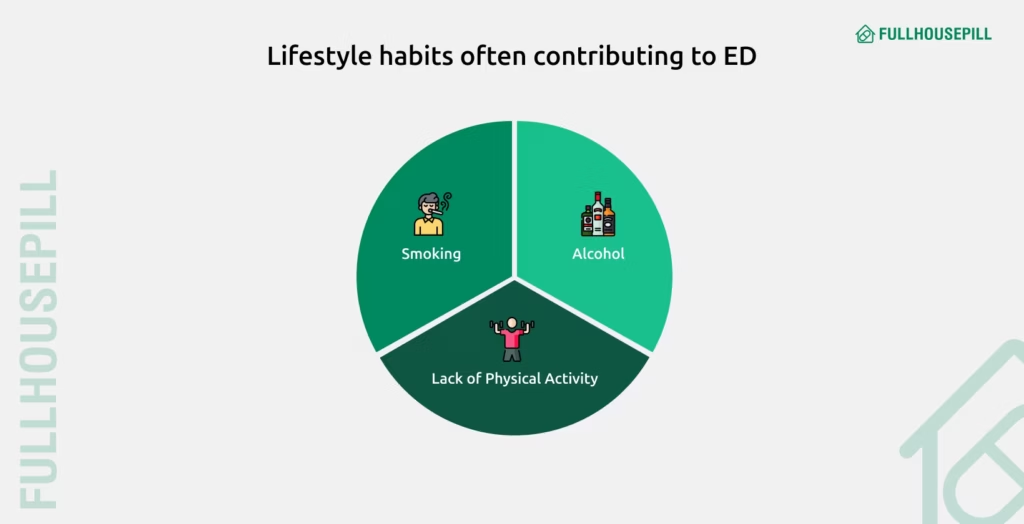
Psychological Factors
Stress, anxiety, depression, and relationship issues are considerable factors in causing ED. Stress might be due to work, studies, relationship issues, body-image problems, or even sexual performance in bed. Prolonged stress may develop into depression, causing impotence.
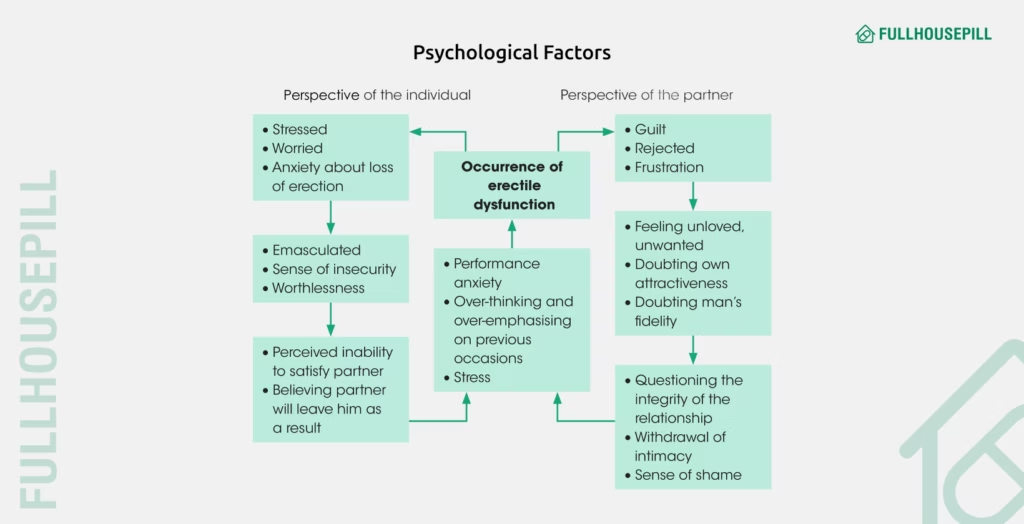
Side Effects of Medications
There are some medicines and recreational drugs that have the potential to cause ED. Below is a list of some such drugs.
- Antidepressants like Amitriptyline, Diazepam, Fluoxetine, Lorazepam, Sertraline, etc.
- Antihistamines like Cimetidine, Hydroxyzine, Ranitidine, etc.
- Diuretics and high blood pressure medicines like Atenolol, Chlorothiazide, Enalapril, Thiazides, Verapamil, etc.
- Parkinson’s disease medications like Benztropine, Levodopa, etc.
- Chemotherapy and hormonal drugs like Busulfan, antiandrogens, Ketoconazole, etc.
- Other medicines like Finasteride, Atropine, Digoxin, Sumatriptan, H2 blockers, etc.
- Alcohol, marijuana, cocaine, barbiturates, and such recreational drugs
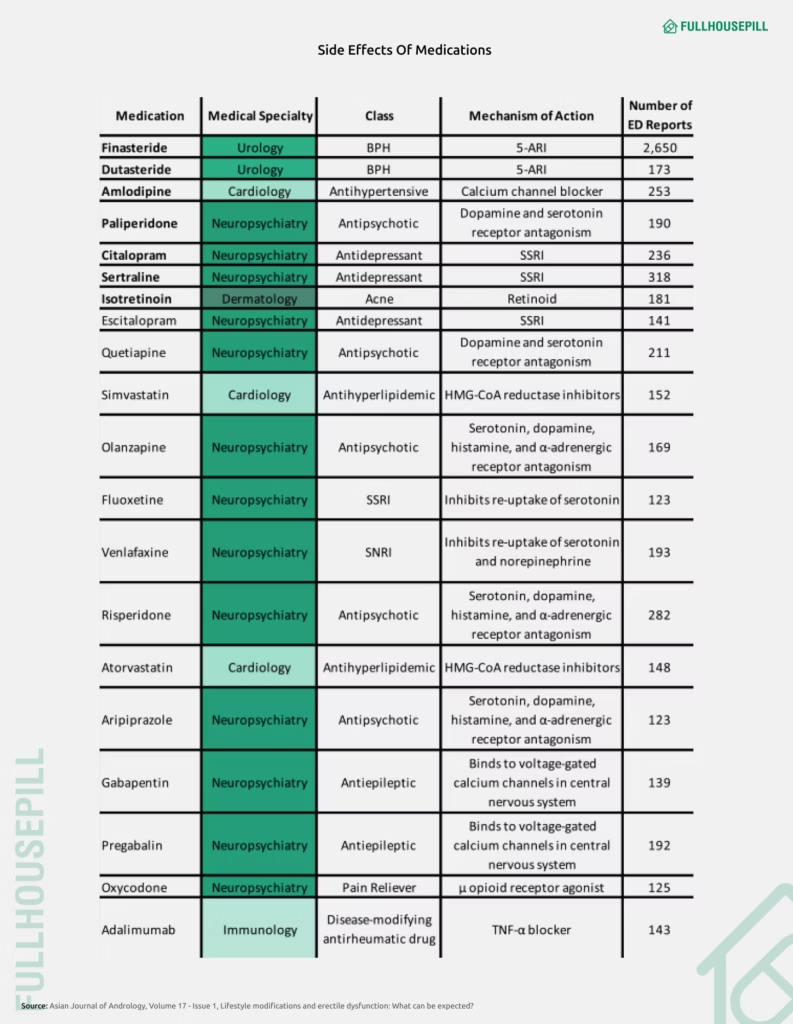
Does Erectile Dysfunction Always Come With Age?
No, erectile dysfunction (ED) does not develop in all older men, and it can also affect younger men. Age is a contributing factor but not a direct cause. The risk of ED increases with age primarily because older men are more likely to develop chronic health conditions that impair vascular, neurological, or hormonal function. These include diabetes, hypertension, cardiovascular disease, and neurological disorders.
Does Morning Wood Stop When You Get Older?
Yes, the incidence of morning wood usually decreases with age. Nocturnal penile tumescence (NPT), commonly known as Morning Wood, refers to spontaneous erections during sleep or upon waking. This is more frequently experienced by younger men as compared to older men. It is not always linked to sexual arousal and may result from hormonal shifts and neural relaxation during REM sleep. Testosterone levels decline with age, which reduces the frequency of morning erections. Although most men start seeing a decline between the ages of 40 and 50, some may continue to get them.
What Are the Treatment Options Available for Erectile Dysfunction?
Several treatment options are available for the effective management of erectile dysfunction (ED), depending on its cause and severity. Getting a proper diagnosis is the first step in determining the most suitable treatment of erectile dysfunction. In some cases, where the underlying cause is unclear, doctors may recommend a combination of therapies based on likely contributing factors. Lifestyle modifications, including regular exercise, healthy eating, quitting smoking, limiting alcohol, and improving sleep, form the foundation of ED management. Psychological factors like stress, performance anxiety, or relationship issues may benefit from individual or couples therapy.

Medication remains the most common treatment of erectile dysfunction, especially PDE5 inhibitors such as sildenafil (Viagra) and tadalafil (Cialis), which work by increasing blood flow to the penis. For those who don’t respond to pills, alternatives like alprostadil injections or intraurethral suppositories can be used. Non-invasive devices like vacuum erection pumps also offer safe options. In advanced cases, surgical treatments such as penile implants or vascular reconstruction may be recommended. Some men explore complementary therapies like yoga or acupuncture, but these should always be discussed with a doctor to ensure safety.
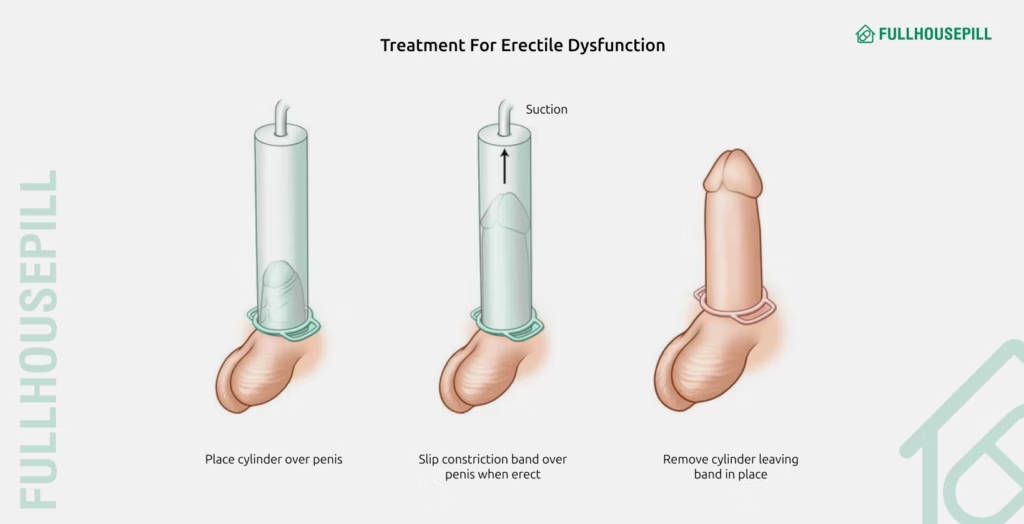
Which Medications Help Treat Erectile Dysfunction?
Medications for erectile dysfunction (ED) work by improving blood flow to the penis during sexual stimulation. Most belong to a class of drugs known as phosphodiesterase type 5 (PDE5) inhibitors. These are prescribed based on the patient’s health status, onset time, duration, and potential side effects.
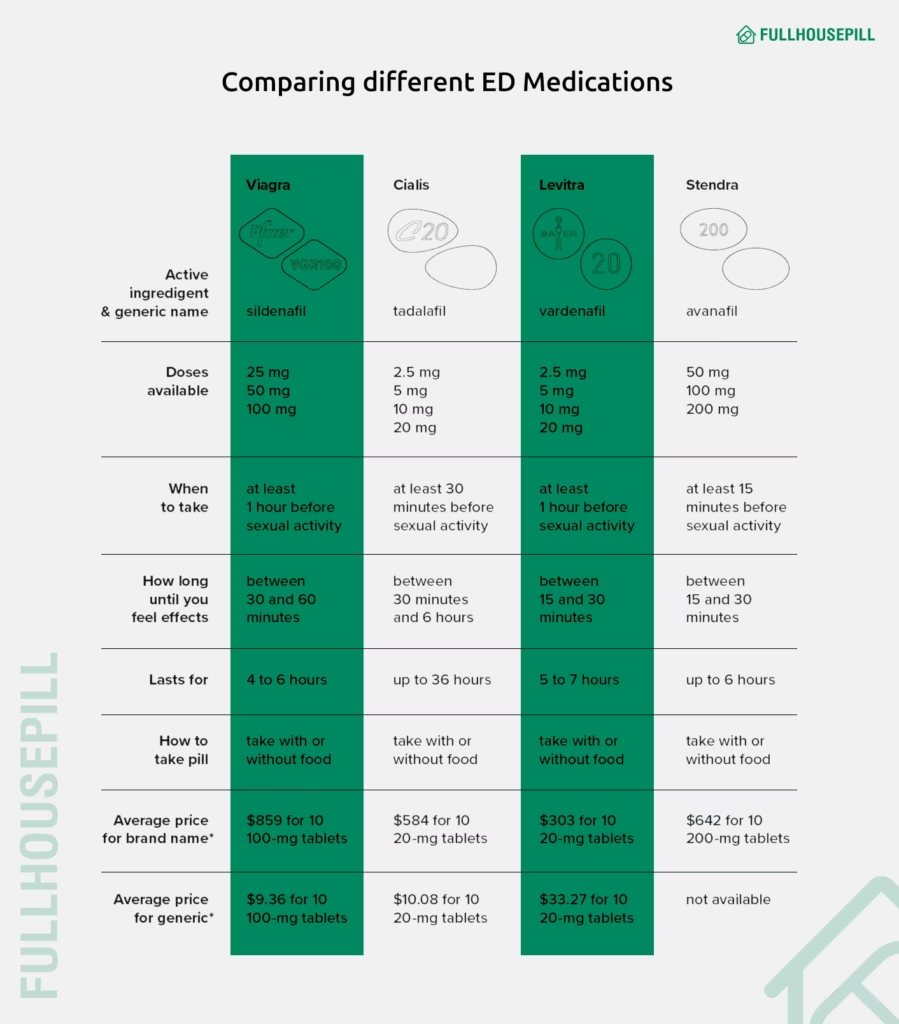
Sildenafil
The sildenafil citrate tablet is the most widely prescribed ED drug, commonly known by the brand name Viagra. It takes effect in 30 to 60 minutes and lasts for about 4 to 6 hours. Sildenafil is ideal for men who want a fast-acting, short-term solution for erectile difficulties.
Tadalafil
A tadalafil tablet offers a longer window of effectiveness, up to 36 hours, and is marketed under the brand name Cialis. It can be used on-demand or taken daily in low doses, making it suitable for men who prefer spontaneity or continuous support.
Vardenafil
The vardenafil tablet works similarly to sildenafil but may be more suitable for men with diabetes or prostate issues. It starts working within 30 to 60 minutes and lasts for 4 to 5 hours. Levitra is its most well-known brand name.
Is Sildenafil Better Than Vardenafil For ED Treatment?
Sildenafil and vardenafil are both effective ED treatments, but their differences lie in patient suitability and tolerability. Both drugs belong to the PDE5 inhibitor class and increase blood flow to the penis during arousal. However, in the comparison of sildenafil vs vardenafil, sildenafil (Viagra) is generally preferred for first-time users due to its widespread use, affordability, and availability in various doses. It typically starts working within 30 to 60 minutes and lasts 4 to 6 hours.
Vardenafil (Levitra), on the other hand, has a slightly longer duration of action (up to 5 hours) and is often reported to have fewer visual side effects. Some clinical studies suggest vardenafil may work better in men with diabetes or prostate issues. The choice depends on individual response, health conditions, and side effect tolerance. A healthcare provider may switch between them to find the best match for the patient.
How to Fix Erectile Dysfunction at a Young Age Naturally?
To treat ED in young men, the focus should be on maintaining a healthy lifestyle. Quit smoking and drinking. Exercise regularly (preferably daily) and eat a healthy diet to keep obesity at bay. Adequate sleep and effective stress management are essential for maintaining sexual health. Supplements such as Ginkgo biloba, Panax ginseng, Yohimbine, DHEA, L-arginine, and Propionyl-L-carnitine have been studied for potential ED benefits, though results are mixed. If necessary, combine these treatment methods with ED medications (Viagra, Levitra, etc). Open communication with a partner can reduce performance anxiety. Therapy may also be beneficial.
Can Porn Induce Erectile Dysfunction?
Yes, excessive pornography use can cause Porn-Induced Erectile Dysfunction (PIED). It may lead to desensitization, performance anxiety, and unrealistic expectations. Over time, the brain may rely on porn for arousal instead of real-life intimacy, disrupting sexual function and making it harder to maintain erections during partner-based intercourse.
